The alimentary tract implant market is valued at USD 5.2 billion in 2025 and is set to reach USD 8.6 billion by 2035, recording an absolute increase of USD 3.4 billion over the forecast period. This translates into a total growth of 64.4%, with the market forecast to expand at a compound annual growth rate (CAGR) of 5.1% between 2025 and 2035. The overall market size is expected to grow by approximately 1.6X during the same period, supported by increasing demand for minimally invasive surgical solutions, growing obesity prevalence globally, and rising applications across bariatric centers, GI endoscopy suites, and colorectal care segments.
The global alimentary tract implant market represents a critical segment within the medical devices and gastroenterology industry, driven by the superior therapeutic profile of implantable medical products and the diverse functional properties of various implant types. These specialized medical products are produced through precision manufacturing processes, providing consistent clinical standards and standardized performance characteristics for various surgical, therapeutic, and interventional applications including obesity treatment, motility disorder management, and specialized gastrointestinal procedures. The processing mechanism enables controlled therapeutic development, making these products particularly suitable for healthcare professionals and applications requiring specific clinical intervention characteristics.
The market encompasses various implant types, procedural grades, and specialized surgical methods tailored for specific clinical requirements. Modern alimentary tract implant production incorporates advanced medical technology, biocompatible material optimization, and enhanced manufacturing techniques that can deliver consistent quality across variable implant formulations while maintaining clinical integrity over extended implantation periods. The integration of quality control systems, regulatory compliance protocols, and standardized manufacturing parameters has further enhanced the value proposition of these medical materials among healthcare manufacturers seeking reliable therapeutic performance and consistent clinical outcomes.
Market dynamics are significantly influenced by rising obesity and gastrointestinal disorder awareness, particularly in developed markets where minimally invasive procedures and advanced medical interventions drive demand for alimentary tract implant materials. The medical device sector's increasing emphasis on innovative implants, advanced therapeutic formulations, and specialized surgical applications has created substantial demand for high-quality alimentary tract implant solutions in bariatric applications, endoscopic procedures, and colorectal interventions. Additionally, the growing trend toward outpatient procedures and advanced surgical technologies has amplified the need for versatile implant materials capable of supporting diverse clinical requirements and therapeutic applications.
Consumer purchasing patterns show a marked preference for certified alimentary tract implant varieties that combine advanced manufacturing methods with consistent therapeutic characteristics, multiple application options, and comprehensive safety profiles for diverse surgical applications. The market has witnessed significant technological advancement in manufacturing efficiency design, quality control systems, and regulatory compliance solutions, making these products more suitable for demanding clinical environments, extended implantation requirements, and safety-critical surgical operations.
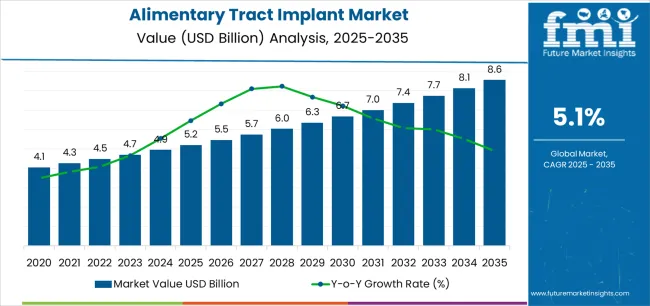
Alimentary Tract Implant Market Key Takeaways
| Metric | Value |
|---|---|
| Estimated Value in (2025E) | USD 5.2 billion |
| Forecast Value in (2035F) | USD 8.6 billion |
| Forecast CAGR (2025 to 2035) | 5.1% |
Between 2025 and 2030, the alimentary tract implant market is projected to expand from USD 5.2 billion to USD 6.7 billion, resulting in a value increase of USD 1.5 billion, which represents 44.1% of the total forecast growth for the decade. This phase of development will be shaped by increasing minimally invasive surgery adoption, rising demand for alternative therapeutic solutions, and growing availability of premium alimentary tract implant varieties across surgical and medical device channels.
Between 2030 and 2035, the market is forecast to grow from USD 6.7 billion to USD 8.6 billion, adding another USD 1.9 billion, which constitutes 55.9% of the overall ten-year expansion. This period is expected to be characterized by the advancement of specialty alimentary tract implant applications, the development of enhanced implant materials for therapeutic improvement, and the expansion of certified alimentary tract implant availability across diverse surgical and medical segments. The growing emphasis on innovative implants and advanced surgical processing will drive demand for premium alimentary tract implant varieties with enhanced functional properties, improved therapeutic characteristics, and superior performance profiles in specialized clinical applications.
Between 2020 and 2024, the alimentary tract implant market experienced steady growth, driven by increasing awareness of minimally invasive surgical benefits and growing recognition of alimentary tract implants' effectiveness in clinical applications following extensive medical technology campaigns. The market developed as manufacturers recognized the advantages of alimentary tract implants over traditional surgical alternatives in procedure-sensitive applications and began seeking specialized products designed for specific therapeutic and surgical requirements. Technological advancement in medical device technology and regulatory compliance began emphasizing the critical importance of maintaining clinical safety while enhancing functional performance and improving therapeutic outcomes across diverse alimentary tract implant applications.
From 2030 to 2035, the market is forecast to grow from USD 6.7 billion to USD 8.6 billion, adding another USD 1.9 billion, which constitutes 55.9% of the overall ten-year expansion. This period is expected to be characterized by the advancement of specialized processing techniques in implant production systems, the integration of quality enhancement protocols for optimal therapeutic retention, and the development of customized implant formulations for high-performance clinical applications. The growing emphasis on material functionality and product reliability will drive demand for premium varieties with enhanced processing capabilities, improved storage stability, and superior clinical performance characteristics.
Between 2020 and 2024, the alimentary tract implant market experienced robust growth, driven by increasing awareness of alternative surgical benefits and growing recognition of specialized implant systems' effectiveness in supporting diverse clinical operations across surgical facilities and specialty medical environments. The market developed as users recognized the potential for alimentary tract implant products to deliver functional advantages while meeting modern requirements for innovative implants and reliable clinical performance. Technological advancement in processing optimization and quality enhancement began emphasizing the critical importance of maintaining material consistency while extending product durability and improving user satisfaction across diverse alimentary tract implant applications.
Market expansion is being supported by the increasing global emphasis on minimally invasive surgical solutions and the corresponding shift toward alternative implant systems that can provide superior therapeutic characteristics while meeting clinical requirements for advanced medical solutions and cost-effective surgical options. Modern medical device manufacturers are increasingly focused on incorporating implant materials that can enhance clinical performance while satisfying demands for consistent, precisely controlled therapeutic development and optimized surgical profiles. Alimentary tract implants' proven ability to deliver clinical excellence, functional versatility, and diverse application possibilities makes them essential materials for surgery-focused professionals and quality-focused medical device manufacturers.
The growing emphasis on innovative implants and advanced surgical processing is driving demand for high-performance alimentary tract implant systems that can support distinctive clinical outcomes and comprehensive therapeutic benefits across bariatric applications, endoscopic procedures, and specialty surgical manufacturing. Clinical preference for implant solutions that combine functional excellence with advanced processing methods is creating opportunities for innovative implementations in both traditional and emerging surgical applications. The rising influence of obesity epidemic and alternative therapeutic approaches is also contributing to increased adoption of alimentary tract implant solutions that can provide authentic functional benefits and reliable therapeutic characteristics.
The market is segmented by implant type, indication, procedure approach, and care setting. By implant type, the market is divided into bariatric restriction & balloons, gastric electrical stimulation/neuromodulation, GI stents/endoluminal scaffolds, and continence/anal sphincter implants. Based on indication, the market is categorized into obesity/metabolic control, motility disorders, GI stricture/obstruction/leak management, and fecal incontinence/continence restoration. By procedure approach, the market includes endoscopic/transoral, laparoscopic bariatric, open/revision surgery, and colorectal/perineal implantation. By care setting, the market encompasses bariatric & metabolic centers, GI & advanced endoscopy suites, colorectal/pelvic floor centers, and hospital OR/other acute care.
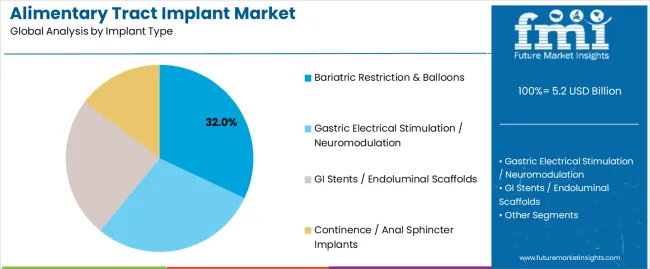
The bariatric restriction & balloons segment is projected to account for 32.0% of the alimentary tract implant market in 2025, reaffirming its position as the leading implant category. Medical device manufacturers and surgical professionals increasingly utilize bariatric restriction & balloon technologies for their superior weight management characteristics, established therapeutic properties, and essential functionality in diverse surgical applications across multiple medical sectors. Bariatric restriction & balloon's proven performance characteristics and established cost-effectiveness directly address user requirements for reliable therapeutic control and optimal surgical precision in bariatric and specialty metabolic applications.
This implant segment forms the foundation of modern obesity treatment patterns, as it represents the implant type with the greatest clinical versatility and established compatibility across multiple surgical systems. Medical industry investments in alternative device technology and surgical optimization continue to strengthen adoption among therapeutic-focused manufacturers. With processors prioritizing device reliability and functional consistency, bariatric restriction & balloon systems align with both performance objectives and clinical requirements, making them the central component of comprehensive obesity management strategies.
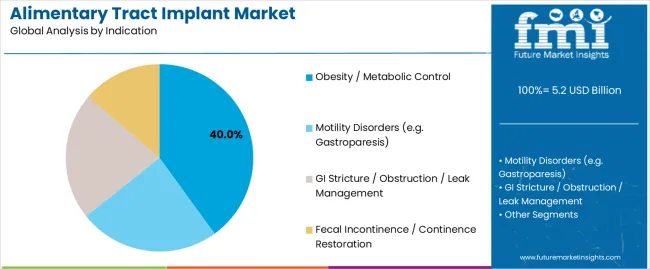
Obesity/metabolic control is projected to represent 40.0% of the alimentary tract implant market in 2025, underscoring its important role as a key indication for performance-focused users seeking superior weight management and enhanced clinical credentials. Medical facilities and surgical operations prefer obesity/metabolic control applications for their established performance characteristics, proven therapeutic development, and ability to maintain exceptional clinical precision while supporting versatile application coverage during diverse surgical activities. Positioned as essential indications for quality-focused clinical processors, obesity/metabolic control offerings provide both functional excellence and clinical optimization advantages.
The segment is supported by continuous improvement in surgical technology and the widespread availability of established performance standards that enable quality assurance and premium positioning at the clinical level. Additionally, medical facilities are optimizing device selections to support application-specific requirements and comprehensive clinical strategies. As surgical technology continues to advance and facilities seek consistent device performance, obesity/metabolic control applications will continue to drive market growth while supporting operational efficiency and quality optimization strategies.
The alimentary tract implant market is advancing rapidly due to increasing minimally invasive surgery adoption and growing need for alternative implant solutions that emphasize superior therapeutic performance across surgical segments and specialty clinical applications. However, the market faces challenges, including competition from other alternative medical device types, price volatility in raw biocompatible materials, and processing complexity considerations affecting development costs. Innovation in medical device technology enhancement and specialized implant formulations continues to influence market development and expansion patterns.
Expansion of Minimally Invasive and Therapeutic Applications
The growing adoption of alimentary tract implants with minimally invasive certification and therapeutic positioning is enabling medical companies to develop surgical products that provide distinctive clinical benefits while commanding premium pricing and enhanced healthcare appeal characteristics. Minimally invasive applications provide superior market positioning while allowing more sophisticated product differentiation features across various surgical categories. Medical companies are increasingly recognizing the market advantages of therapeutic implant positioning for comprehensive clinical outcomes and premium-focused surgical marketing.
Integration of Innovation and Performance Enhancement Systems
Modern alimentary tract implant manufacturers are incorporating advanced innovation enhancement, performance improvement capabilities, and therapeutic supplementation systems to enhance product functionality, improve clinical effectiveness, and meet healthcare demands for enhanced surgical solutions. These systems improve product performance while enabling new applications, including specialty surgical programs and specialized clinical protocols. Advanced performance integration also allows manufacturers to support premium product positioning and clinical assurance beyond traditional implant performance requirements.
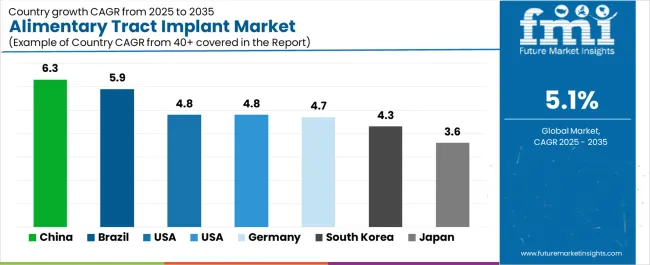
| Countries | CAGR (2025 to 2035) |
|---|---|
| China | 6.3% |
| Brazil | 5.9% |
| USA | 4.8% |
| UK | 4.8% |
| Germany | 4.7% |
| South Korea | 4.3% |
| Japan | 3.6% |
The alimentary tract implant market is experiencing robust growth globally, with China leading at a 6.3% CAGR through 2035, driven by the expanding medical device sector, growing surgical technology adoption, and increasing adoption of implant materials. Brazil follows at 5.9%, supported by rising surgical capabilities, expanding healthcare industry, and growing acceptance of implant materials. USA shows growth at 4.8%, emphasizing established surgical standards and comprehensive implant development. UK records 4.8%, focusing on surgical industry modernization and medical device market growth. Germany demonstrates 4.7% growth, prioritizing advanced surgical technologies and clinical-focused medical products.
The report covers an in-depth analysis of 40+ countries, top-performing countries are highlighted below.
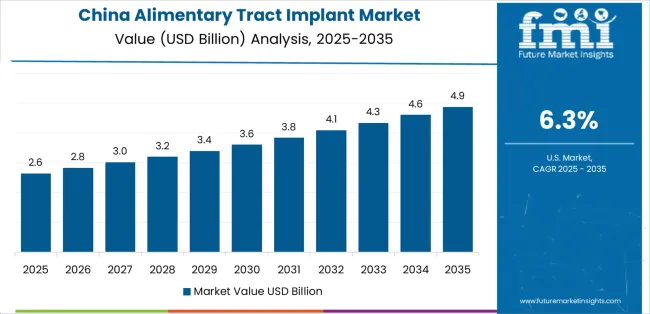
Revenue from alimentary tract implant consumption and sales in China is projected to exhibit exceptional growth with a CAGR of 6.3% through 2035, driven by the country's rapidly expanding medical device sector, favorable healthcare policies toward surgical implants, and initiatives promoting implant development across major healthcare regions. China's position as a global healthcare leader and increasing focus on processed surgical materials are creating substantial demand for high-quality alimentary tract implants in both domestic and international markets. Major medical companies and device distributors are establishing comprehensive implant production capabilities to serve growing demand and emerging surgical opportunities.
Revenue from alimentary tract implant products in Brazil is expanding at a CAGR of 5.9%, supported by rising domestic healthcare consumption, growing surgical technology adoption, and expanding device distributor capabilities. The country's developing healthcare infrastructure and increasing investment in surgical technologies are driving demand for alimentary tract implants across both traditional and modern healthcare applications. International device companies and domestic processors are establishing comprehensive operational networks to address growing market demand for alternative implant products and efficient surgical processing solutions.
Revenue from alimentary tract implant products in USA is projected to grow at a CAGR of 4.8% through 2035, supported by the country's mature healthcare processing standards, established surgical implant regulations, and leadership in specialty implant technology. USA's sophisticated healthcare standards and strong support for alternative device systems are creating steady demand for both traditional and innovative implant varieties. Leading device manufacturers and specialty distributors are establishing comprehensive operational strategies to serve both domestic markets and growing export opportunities.
Revenue from alimentary tract implant products in the UK is projected to grow at a CAGR of 4.8% through 2035, driven by the country's emphasis on healthcare industry development, device processing growth, and growing distributor capabilities. British manufacturers and processing facilities consistently seek quality-focused devices that enhance product performance and support processing excellence for both traditional and modern healthcare applications. The country's position as a European healthcare leader continues to drive innovation in specialized implant applications and healthcare processing standards.
Revenue from alimentary tract implant products in Germany is projected to grow at a CAGR of 4.7% through 2035, supported by established healthcare standards, mature surgical markets, and emphasis on innovative alternatives across healthcare and medical sectors. German manufacturers and specialty processors prioritize quality devices and consistent performance, creating steady demand for premium implant solutions. The country's comprehensive market innovation and established healthcare practices support continued development in specialized applications.
Revenue from alimentary tract implant products in South Korea is projected to grow at a CAGR of 4.3% through 2035, supported by established healthcare standards, mature surgical markets, and emphasis on innovative alternatives across healthcare and medical sectors. Korean manufacturers and specialty processors prioritize quality devices and consistent performance, creating steady demand for premium implant solutions. The country's comprehensive market maturity and established healthcare practices support continued development in specialized applications.
Revenue from alimentary tract implant products in Japan is projected to grow at a CAGR of 3.6% through 2035, supported by the country's emphasis on device quality, healthcare excellence, and advanced processing technology integration requiring efficient device solutions. Japanese healthcare facilities and quality-focused operations prioritize technical performance and surgical precision, making specialized implants essential materials for both traditional and modern healthcare applications. The country's comprehensive healthcare leadership and advancing quality patterns support continued market expansion.
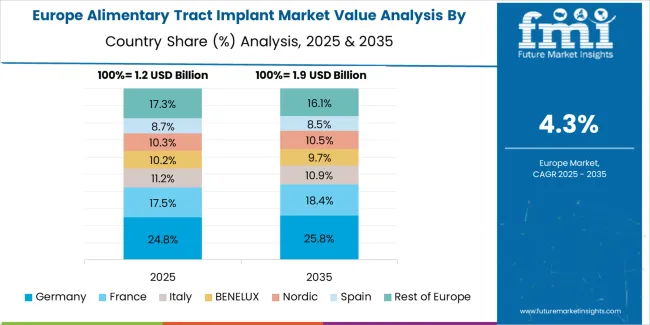
The Europe alimentary tract implant market is projected to grow from USD 1.56 billion in 2025 to USD 2.57 billion by 2035, registering a CAGR of 5.1% over the forecast period. Germany is expected to maintain its leadership position with a 30.0% market share in 2025, declining slightly to 29.5% by 2035, supported by its advanced healthcare infrastructure and major surgical centers including Berlin and Munich.
France follows with a 22.0% share in 2025, projected to reach 22.5% by 2035, driven by comprehensive healthcare modernization programs and surgical implant initiatives. The United Kingdom holds a 20.0% share in 2025, expected to decrease to 19.5% by 2035 due to market maturation. Italy commands a 15.0% share, while Spain accounts for 8.0% in 2025. The Rest of Europe region is anticipated to gain momentum, expanding its collective share from 5.0% to 5.5% by 2035, attributed to increasing implant adoption in Nordic countries and emerging Eastern European markets implementing healthcare technology programs.
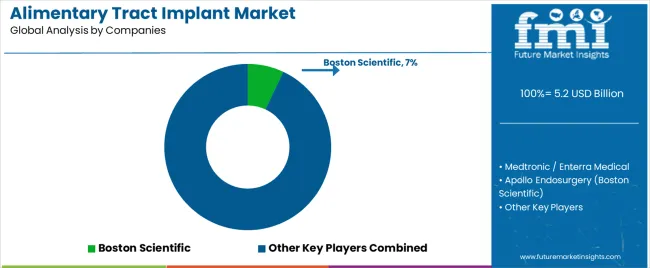
The alimentary tract implant market is characterized by competition among established medical device manufacturers, specialized implant companies, and integrated surgical solution providers. Companies are investing in advanced medical technologies, specialized manufacturing engineering, product innovation capabilities, and comprehensive distribution networks to deliver consistent, high-quality, and reliable alimentary tract implant products. Innovation in manufacturing efficiency optimization, quality control advancement, and clinical-focused product development is central to strengthening market position and customer satisfaction.
Boston Scientific leads the market with 7.0% share with a strong focus on medical device technology innovation and comprehensive surgical solutions, offering surgical and specialty systems with emphasis on quality excellence and clinical heritage. Medtronic/Enterra Medical provides integrated advanced medical solutions with a focus on surgical market applications and functional device networks. Apollo Endosurgery (Boston Scientific) delivers comprehensive implant products with a focus on surgical positioning and clinical quality. Ethicon (Johnson & Johnson) specializes in surgical-based implant systems with an emphasis on clinical applications. Coloplast focuses on comprehensive implant processing with advanced medical technology and surgical positioning capabilities.
| Items | Values |
|---|---|
| Quantitative Units (2025) | USD 5.2 billion |
| Implant Type | Bariatric Restriction & Balloons, Gastric Electrical Stimulation/Neuromodulation, GI Stents/Endoluminal Scaffolds, Continence/Anal Sphincter Implants |
| Indication | Obesity/Metabolic Control, Motility Disorders, GI Stricture/Obstruction/Leak Management, Fecal Incontinence/Continence Restoration |
| Procedure Approach | Endoscopic/Transoral, Laparoscopic Bariatric, Open/Revision Surgery, Colorectal/Perineal Implantation |
| Care Setting | Bariatric & Metabolic Centers, GI & Advanced Endoscopy Suites, Colorectal/Pelvic Floor Centers, Hospital OR/Other Acute Care |
| Regions Covered | North America, Europe, Asia-Pacific, Latin America, Middle East & Africa |
| Countries Covered | USA, UK, Germany, France, Japan, South Korea, China, Brazil, and 40+ countries |
| Key Companies Profiled | Boston Scientific, Medtronic, Apollo Endosurgery, Ethicon, Coloplast, and other leading alimentary tract implant companies |
| Additional Attributes | Dollar sales by implant type, indication, procedure approach, care setting, and region; regional demand trends, competitive landscape, technological advancements in implant processing, quality optimization initiatives, clinical enhancement programs, and premium product development strategies |
The global alimentary tract implant market is estimated to be valued at USD 5.2 billion in 2025.
The market size for the alimentary tract implant market is projected to reach USD 8.6 billion by 2035.
The alimentary tract implant market is expected to grow at a 5.1% CAGR between 2025 and 2035.
The key product types in alimentary tract implant market are bariatric restriction & balloons, gastric electrical stimulation / neuromodulation, gi stents / endoluminal scaffolds and continence / anal sphincter implants.
In terms of indication, obesity / metabolic control segment to command 40.0% share in the alimentary tract implant market in 2025.






Full Research Suite comprises of:
Market outlook & trends analysis
Interviews & case studies
Strategic recommendations
Vendor profiles & capabilities analysis
5-year forecasts
8 regions and 60+ country-level data splits
Market segment data splits
12 months of continuous data updates
DELIVERED AS:
PDF EXCEL ONLINE
Traction Motors Market Growth - Trends & Forecast 2025 to 2035
Traction Battery Market Growth - Trends & Forecast 2025 to 2035
Traction Inverter Market
Traction Transformer Market
Retractable Needle Safety Syringes Market Size and Share Forecast Outlook 2025 to 2035
Extraction Kits Market Analysis - Size, Share, and Forecast Outlook 2025 to 2035
Retractable Lift Market
Retractable Needles Market
Extracts and Distillates Market
DC Traction Switchgear Market Size and Share Forecast Outlook 2025 to 2035
EV Traction Inverter Market Size and Share Forecast Outlook 2025 to 2035
Contract Logistics Market Size and Share Forecast Outlook 2025 to 2035
Contract Furniture Market Analysis by Product Type, End-users, Distribution Channel, and Region from 2025 to 2035.
Contract Lifecycle Management Market Growth – Trends & Forecast 2025 to 2035
Contractual Cleaning Services Market Growth - Trends & Forecast 2025 to 2035
Contract Management Software Market Analysis By Solution, By Enterprise Size, By Business Function and Industry Through 2035
Contract Packaging Market from 2025 to 2035
Contract Blending Services Market
Contract Dose Manufacturing Market
Skin Traction Kits Market

Thank you!
You will receive an email from our Business Development Manager. Please be sure to check your SPAM/JUNK folder too.
Chat With
MaRIA